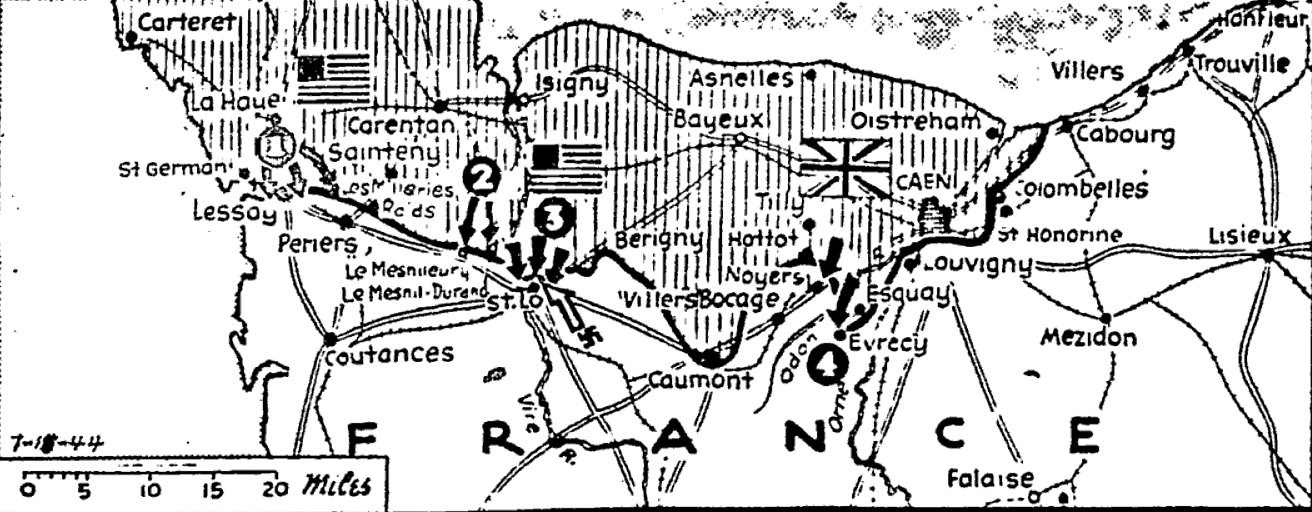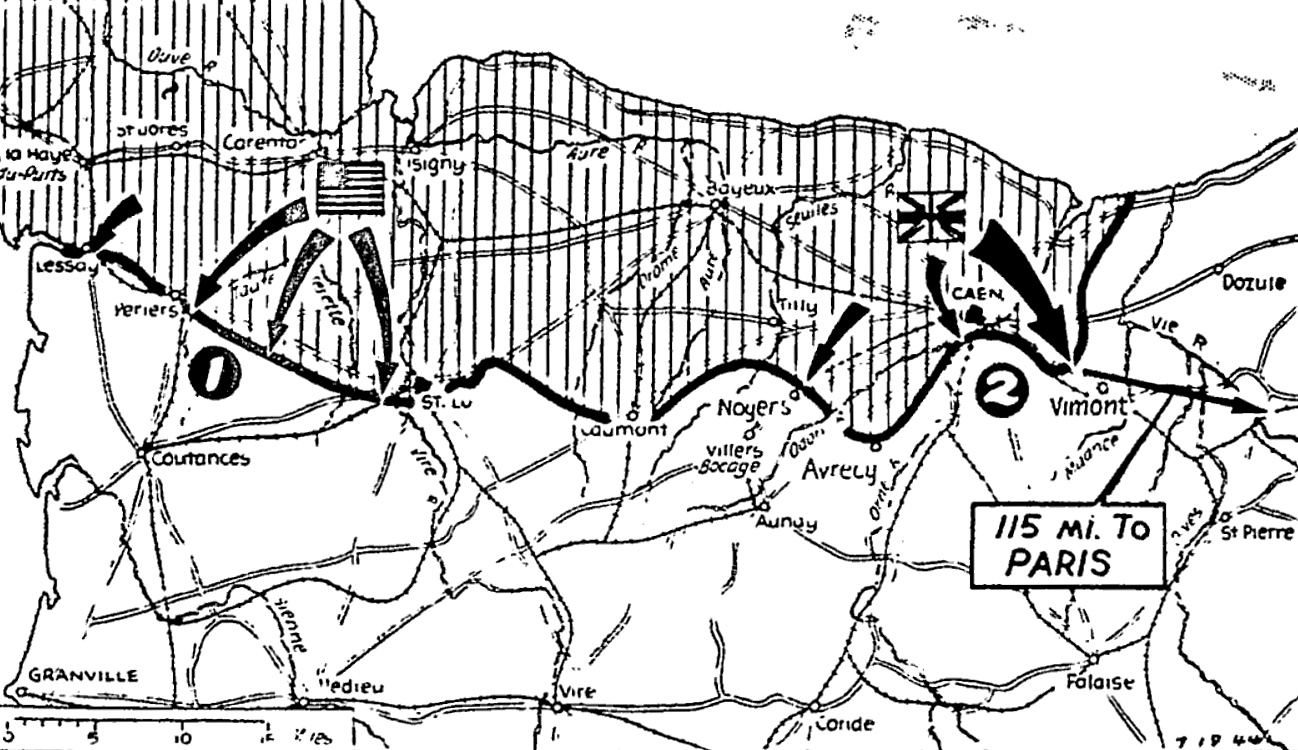The Pittsburgh Press (July 18, 1944)
Saint-Lô seized by Yanks
Showdown struggle on in Normandy as Germans reel back
By Virgil Pinkley, United Press staff writer
The Yanks capture Saint-Lô in their bitterest battle of the Normandy campaign. The Americans seized Saint-Lô (3) today after U.S. vanguards had driven into the town yesterday and then been driven out. There was no official word of the fighting in the Lessay–Périers area, although the Nazi radio said the Yanks had started an expected attack against Lessay(1). The Americans seized a ridge overlooking the Saint-Lô–Périers highway halfway between the two towns (2). Fierce fighting continued around Noyers and Évrecy (4), towns which the British entered yesterday.
SHAEF, London, England –
The U.S. 1st Army captured bitterly defended Saint-Lô today and the British 2nd Army broke through below Caen behind a screen of almost 8,000 tons of bombs as the German line long containing the Normandy beachhead buckled in two vital sectors.
The showdown Battle of Normandy was in full swing, and Gen. Sir Bernard L. Montgomery’s Allied armies had scored two significant victories in the massive onslaught aimed at breaking out of the German ring for a concerted sweep inland.
Soon after field dispatches announced the fall of Saint-Lô at the climax to the toughest U.S. battle in France, Gen. Montgomery announced that his armor had achieved a major breakthrough across the Orne below Caen.
A statement from Gen. Montgomery’s headquarters said:
The town of Vaucelles, lying on the south side of the Orne opposite Caen, is being cleared of the enemy, and strong armored and mobile forces are operating in the open country further to the southeast and south.
The most concentrated air bombardment in history paved the way for the British-Canadian breach in the German lines which broke the stalemate following the capture of Caen and sent the Allied armor careening forward toward the interior of France across the flat farmlands to the south and southeast.
8,000 tons of bombs
Fifteen hundred heavy bombers, 500 medium and light bombers, and hundreds of lighter plans pounded the German positions within a semicircle lying roughly seven miles around Caen between 6:00 and 9:00 a.m., cascading nearly 8,000 tons of explosives into a 75-square-mile area.
Four thousand Halifax and Lancaster heavy bombers of the Royal Air Force alone delivered 5,000 tons of bombs in 45 minutes. Six hundred U.S. Liberators swarmed in later to unload another great weight on the crumbling German positions.
Supreme Headquarters refused for the time being to delineate the breakthrough. The concentration of airpower indicated, however, that the attack was probably aimed across the Orne northeast of Caen, and broke out of the bridgehead maintained across the lower Orne since D-Day.
Nazi collapse threatened
The simultaneous reports from the front that Saint-Lô had fallen and the Germans were falling back in apparent preparation to abandon Périers and Lessay meant that the Normandy front was aflame everywhere, rolling forward, and threatening to collapse the overall German defenses if the original impetus can be maintained.
The following statement was issued from Gen. Montgomery’s headquarters:
Early this morning, British and Canadian troops of the 2nd Army attacked and broke through into the area east of the Orne and southeast of Caen.
The attack was preceded and supported by a very great weight of airpower organized by the Allied Expeditionary Force.
The town of Vaucelles, lying on the south side of the Orne opposite Caen, is being cleared of the enemy, and strong armored and mobile forces are operating in open country further to the southeast and south.
Heavy fighting continues. Gen. Montgomery is well satisfied with the progress made in the first day’s fighting of this battle.
Gen. Montgomery’s flat statement that a breakthrough had been achieved and his forces were advancing across the ideal tank country below Caen showed that the 2nd Army had achieved a success of gigantic proportions, which was expected to have tremendous effects on the entire battlefront.
Complete surprise
Complete surprise was achieved in the early morning offensive, despite the fact that the Germans had observation facilities over the entire length of the Orne.
This was due largely to the fact, which can now be revealed, that the series of British-Canadian assaults southwest of Caen represented an elaborate scheme to outwit Marshal Erwin Rommel on the location of the main attack. Actually, these attacks were limited in scope, involving a relatively small part of the great mass of tanks and infantry pouring into the bridgehead for 44 days.
The Germans had been packed into the Vaucelles suburb of Caen in strength, facing the British and Canadians across the Orne in the city, for nine days. But tonight, they were being cleared out of this last large inhabited area in the southwest environs of Caen.
United Press writer Henry T. Gorrell reported the conquest of the ancient citadel anchoring the center of the German defense line in a dispatch filed from the battlefront at 6:30 p.m.
“Saint-Lô fell this afternoon,” Mr. Gorrell said in his flash disclosing the significant U.S. victory after a bloody, swaying battle which for ferocity outdid the earlier fight for Cherbourg.
Strongest Nazi position
With Saint-Lô fallen after an all-out defense, the Germans were deprived of their strongest position for a stand on the perimeter of the Allied beachhead.
Coincident with their grudging surrender of Saint-Lô under the heaviest American pressure, the Germans carried out a general withdrawal along most of the line for between a little more than a mile and nearly two miles, Gorrell reported.
The Germans appeared to be straightening out their lines preparatory to taking up defense positions along the east-west ridges in Normandy, Mr. Gorrell said.
Fall foreshadowed
The fall of Saint-Lô was foreshadowed by the disclosure that U.S. assault forces had stormed back into the town hub of seven main roads radiating to all parts of Normandy, and the admission by the German radio that the furious battle was nearing a climax as U.S. troops closed in from three sides.
Lt. Gen. Omar N. Bradley’s army drove within a mile and a half of Saint-Lô July 12. Since then, the Americans and Germans had been slugging it out around the town.
Yesterday, the U.S. vanguard crashed into Saint-Lô, which is 175 miles west of Paris, only to be driven out and to forge back through its outskirts for violent fighting with bayonet and grenade in its battle-scarred streets.
Suburb captured
Shortly before Mr. Gorrell reported the capture of Saint-Lô, it was disclosed that the Americans had seized suburban Sainte-Croix-de-Saint-Lô, a mile from the heart of the wrecked town.
Allied headquarters announced that U.S. shock troops had brought the arterial highway northwestward to Périers under small-arms fire from a ridge 200 yards above it and about midway between the towns.



